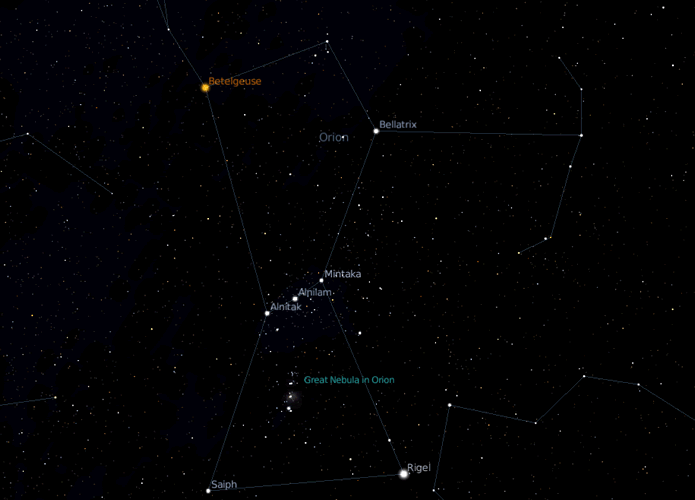Constellation List
6.4 - Understand why there is a range of constellation, asterism and star names among different culturesThe list of constellations we use in astronomy today was handed down by a script written by Greek astronomer Ptolemy who was born in the first century. Many of the constellations were based on mythology, mostly Greek mythology.
Additional constellations were added to the common list when explorers charted the southern hemisphere constellations and named them after new animals they discovered or after parts of their boats. The list was formalised into 88 constellations by the International Astronomy Union in the 1920s. The boundaries of these constellations were also formalised at the time so you may hear about Ophiuchus as a zodiacal constellation which it was not considered to be previously.
The Chinese, Indian and Aboriginal cultures all reference their own constellations as part of their culture.
A common astronomical constellation to look out for is Ursa Major, Latin for 'Great Bear'. Like many of these constellations it doesn't look a bear. There is a Greek mythological behind the constellations where the Great and Little bears (Ursa Minor) where thrown into the sky by Zeus. Ursa Major is a familiar constellation in the northern hemisphere and its prominent asterism has different names. In the UK and Ireland it is known as a plough because it looks like the agricultural tool. Other countries have different names for it; Great Wagon (Scandinavia), Saucepan (Holland), Salmon Net (Hungary), 'Seven stars of the north' (Korea) and 'Big Dipper' (USA).
Some constellations require more imagination that others to reason why they were given that name. You might view Sagittarius and wonder does it look like an archer or does it really look like a teapot?
Constellations
List of all 88 modern constellations. Links point to Wikipedia entry. Abbreviations are frequently displayed on star maps. The origin refers to when the constellation was commonly assumed in a common star atlas listed at the end of the table. 'A' refers to Ancient.
| Constellation | Abbreviations | English | Origin |
|---|---|---|---|
| Andromeda | AND | Chained Lady | A |
| Antlia | ANT | Air Pump | 1763 |
| Apus | APS | Bird of Paradise | 1603 |
| Aquarius | AQR | Water Bearer | A |
| Aquila | AQL | Eagle | A |
| Ara | ARA | Altar | A |
| Aries | ARI | Ram | A |
| Auriga | AUR | Charioteer | A |
| Boötes | BOO | Herdsman | A |
| Caelum | CAE | Engraving Tool | 1763 |
| Camelopardalis | CAM | Giraffe | 1613 |
| Cancer | CNC | Crab | A |
| Canes Venatici | CVN | Hunting Dogs | 1690 |
| Canis Major | CMA | Larger Dog | A |
| Canis Minor | CMI | Smaller Dog | A |
| Capricornus | CAP | Water Goat | A |
| Carina | CAR | Keel | 1763 |
| Cassiopeia | CAS | Queen | A |
| Centaurus | CEN | Centaur | A |
| Cepheus | CEP | King | A |
| Cetus | CET | Whale/Sea Monster | A |
| Chamaeleon | CHA | Chameleon | 1603 |
| Circinus | CIR | Compasses | A |
| Columba | COL | Dove | 1592 |
| Coma Berenices | COM | Berenices Hair | 1603 |
| Corona Australis | CRA | Southern Crown | A |
| Corona Borealis | CRB | Northern Crown | A |
| Corvus | CRV | Crow, Raven | A |
| Crater | CRT | Cup | A |
| Crux | CRU | Southern Cross | 1603 |
| Cygnus | CYG | Swan | A |
| Delphinus | DEL | Dolphin | A |
| Dorado | DOR | Swordfish | 1603 |
| Draco | DRA | Dragon | A |
| Equuleus | EQL | Little Horse | A |
| Eridanus | ERI | River | A |
| Fornax | FOR | Furnace | 1763 |
| Gemini | GEM | Twins | A |
| Grus | GRU | Crane | 1603 |
| Hercules | HER | Hero; Hercules | A |
| Horologium | HOR | Clock | 1763 |
| Hydra | HYA | Water Serpent | A |
| Hydrus | HYI | Water Snake | 1603 |
| Indus | IND | Indian | 1603 |
| Lacerta | LAC | Lizard | 1690 |
| Leo | LEO | Lion | A |
| Leo Minor | LMI | Smaller Lion | 1690 |
| Lepus | LEP | Hare | A |
| Libra | LIB | Scales | A |
| Lupus | LUP | Wolf | A |
| Lynx | LYN | Lynx | 1690 |
| Lyra | LYR | Lyre | A |
| Mensa | MEN | Table | 1763 |
| Microscopium | MIC | Microscope | 1763 |
| Monoceros | MON | Unicorn | 1613 |
| Musca | MUS | Fly | 1603 |
| Norma | NOR | Square | 1763 |
| Octans | OCT | Octant | 1763 |
| Ophiuchus | OPH | Serpent Bearer | A |
| Orion | ORI | Hunter; Orion | A |
| Pavo | PAV | Peacock | 1603 |
| Pegasus | PEG | Winged Horse | A |
| Perseus | PER | Perseus the Hero | A |
| Phoenix | PHE | Phoenix | 1603 |
| Pictor | PIC | Easel | 1763 |
| Pisces | PSC | Fishes | A |
| Piscis Austrinus | PSA | Southern Fish | A |
| Puppis | PUP | Stern | A |
| Pyxis | PYX | Compass | 1763 |
| Reticulum | RET | Net | 1763 |
| Sagitta | SGE | Arrow | A |
| Sagittarius | SGR | Archer | A |
| Scorpius | SCO | Scorpion | A |
| Sculptor | SCL | Sculptor | 1763 |
| Scutum | SCT | Shield | 1690 |
| Serpens | SER | Serpent | A |
| Sextans | SEX | Sextant | 1690 |
| Taurus | TAU | Bull | A |
| Telescopium | TEL | Telescope | 1763 |
| Triangulum | TRI | Triangle | A |
| Triangulum Australe | TRA | Southern Triangle | 1603 |
| Tucana | TUC | Toucan | 1603 |
| Ursa Major | UMA | Greater Bear | A |
| Ursa Minor | UMI | Smaller Bear | A |
| Vela | VEL | Sails | 1763 |
| Virgo | VIR | Maiden | A |
| Volans | VOL | Flying Fish | 1603 |
| Vulpecula | VUL | Fox | 1690 |
Ancient (Ptolemy)
1592, Plancius, split from Canis Major
1603, Uranometria, created by Keyser and de Houtman
1613, Plancius
1690, Firmamentum Sobiescianum, Hevelius
1763, Lacaille
Questions
Why do astronomers use a common set of constellations?
Links
Skywise Unlimited Constellations
Australian Indigenous Astronomy Aboriginal Astronomy
Chinese Constellations The Four Quarters



 | © All Rights Reserved |
| © All Rights Reserved |